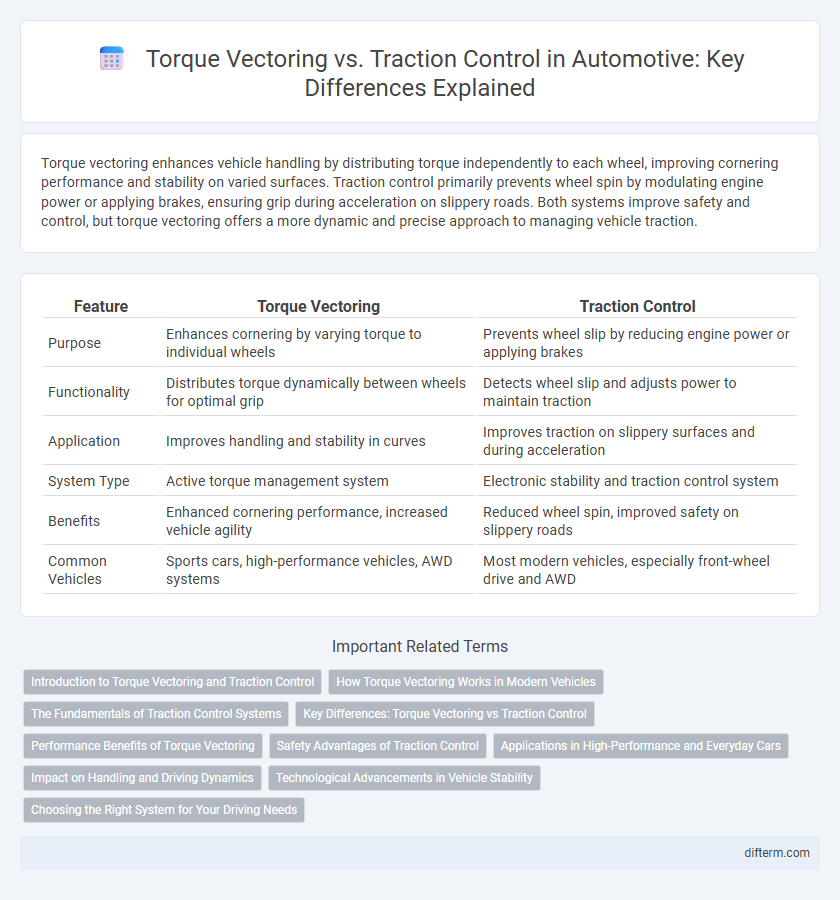Torque vectoring enhances vehicle handling by distributing torque independently to each wheel, improving cornering performance and stability on varied surfaces. Traction control primarily prevents wheel spin by modulating engine power or applying brakes, ensuring grip during acceleration on slippery roads. Both systems improve safety and control, but torque vectoring offers a more dynamic and precise approach to managing vehicle traction.
Table of Comparison
| Feature | Torque Vectoring | Traction Control |
|---|---|---|
| Purpose | Enhances cornering by varying torque to individual wheels | Prevents wheel slip by reducing engine power or applying brakes |
| Functionality | Distributes torque dynamically between wheels for optimal grip | Detects wheel slip and adjusts power to maintain traction |
| Application | Improves handling and stability in curves | Improves traction on slippery surfaces and during acceleration |
| System Type | Active torque management system | Electronic stability and traction control system |
| Benefits | Enhanced cornering performance, increased vehicle agility | Reduced wheel spin, improved safety on slippery roads |
| Common Vehicles | Sports cars, high-performance vehicles, AWD systems | Most modern vehicles, especially front-wheel drive and AWD |
Introduction to Torque Vectoring and Traction Control
Torque vectoring enhances vehicle handling by dynamically distributing torque between individual wheels based on driving conditions, improving cornering performance and stability. Traction control systems prevent wheel slip during acceleration by selectively reducing engine power or applying brakes to specific wheels, maintaining optimal grip on various surfaces. Both technologies are integral to modern automotive safety and performance, with torque vectoring focusing on proactive torque distribution and traction control emphasizing slip prevention.
How Torque Vectoring Works in Modern Vehicles
Torque vectoring in modern vehicles dynamically distributes engine torque between wheels to optimize traction and handling, using sensors and electronic control units to monitor wheel speed, steering angle, and yaw rate. Unlike traditional traction control, which simply reduces power or applies brakes to slipping wheels, torque vectoring actively adjusts torque delivery to each wheel for improved cornering stability and performance. This advanced system enhances vehicle agility, especially in high-performance and all-wheel-drive cars, by maximizing grip and minimizing understeer or oversteer.
The Fundamentals of Traction Control Systems
Traction control systems optimize wheel grip by modulating engine power and applying brakes to prevent wheel slip during acceleration, enhancing vehicle stability and safety. These systems rely on sensors detecting wheel speed differences and adjust torque distribution to maintain optimal traction. Unlike torque vectoring, which varies torque between wheels for improved cornering performance, traction control primarily focuses on preventing loss of traction under varying road conditions.
Key Differences: Torque Vectoring vs Traction Control
Torque vectoring actively distributes torque between individual wheels to enhance cornering performance and vehicle stability, while traction control primarily prevents wheel slip by reducing engine power or applying brakes during acceleration. Torque vectoring systems improve handling dynamics by optimizing power delivery in real-time, whereas traction control maintains grip on low-traction surfaces for improved safety. The key difference lies in torque vectoring's proactive approach to driving dynamics versus traction control's reactive intervention to maintain traction.
Performance Benefits of Torque Vectoring
Torque vectoring enhances vehicle performance by dynamically distributing torque between individual wheels, improving cornering precision and stability. This system optimizes traction during aggressive driving maneuvers, resulting in better acceleration and reduced understeer compared to traditional traction control. By actively managing wheel torque, torque vectoring maximizes grip and responsiveness, delivering superior handling on both dry and slippery surfaces.
Safety Advantages of Traction Control
Traction control enhances vehicle safety by preventing wheel slip during acceleration, maintaining optimal grip on slippery or uneven surfaces. Unlike torque vectoring, which focuses on improving handling and cornering performance, traction control directly reduces the risk of skidding and loss of vehicle control in adverse driving conditions. This system automatically modulates engine power and applies brake force to individual wheels, ensuring stable and predictable vehicle behavior.
Applications in High-Performance and Everyday Cars
Torque vectoring enhances vehicle handling and stability by actively distributing torque between wheels, making it ideal for high-performance sports cars and aggressive cornering scenarios. Traction control prevents wheel slip during acceleration by modulating engine power or applying brakes, improving safety and drivability in everyday cars on slippery or uneven surfaces. High-performance vehicles leverage torque vectoring for dynamic agility, while traction control remains essential in daily driving for maintaining grip and preventing skidding.
Impact on Handling and Driving Dynamics
Torque vectoring significantly enhances handling by dynamically distributing torque between wheels, improving cornering stability and agility on varying road conditions. Traction control primarily prevents wheel slip during acceleration, aiding straight-line stability but offering limited influence on lateral dynamics. The integration of torque vectoring systems leads to more responsive steering and improved vehicle balance, delivering superior driving dynamics compared to conventional traction control.
Technological Advancements in Vehicle Stability
Torque vectoring enhances vehicle stability by dynamically distributing torque to individual wheels, improving cornering performance and reducing understeer compared to traditional traction control systems that primarily limit wheel slip. Advanced torque vectoring systems integrate with electronic stability control and brake-by-wire technologies, enabling precise adjustments during high-speed maneuvers and on varying road conditions. Emerging developments in AI-driven algorithms and sensor fusion further optimize torque vectoring responsiveness, significantly elevating overall vehicular handling and safety.
Choosing the Right System for Your Driving Needs
Torque vectoring enhances cornering performance by actively distributing torque between wheels for improved handling, while traction control primarily prevents wheel slip to maintain stability on slippery surfaces. Drivers seeking aggressive, precision handling in sporty or performance vehicles benefit most from torque vectoring systems that optimize power delivery during dynamic driving. For everyday commuting or adverse weather conditions, traction control provides essential safety by stabilizing the vehicle, making it the preferred choice for consistent grip and control.
torque vectoring vs traction control Infographic

 difterm.com
difterm.com